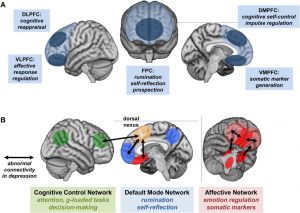تحریک مغناطیسی مغز تی ام اس باعث کاهش احساسات منفی میشود
مطالعه ی جدید منتشر شده در روانپزشکی بیولوژیکی، علم اعصاب شناختی و تصویری نشان میدهد که پردازش احساسات منفی میتواند با تنظیم میزان تحریک پذیری بخش راست پیشین مغز تقویت و یا تضعیف شود.
نقش تحریک مغناطیسی مغز تی ام اس باعث کاهش احساسات منفی میشود
محققان دانشگاه مانستر آلمان، به کمک تحریک مغناطیسی مغز، توسط تکنیکی به نام تحریک مغناطیسی مکرر (rTMS) ، نشان دادند که علیرغم به کار گیری محرک مهارکننده ای که در حال حاضر به منظور درمان افسردگی استفاده میشود، تحریک هیجانی، پاسخ فرد به تصاویر ترسناک را بهتر کاهش میدهد.
کلینیک چند تخصصی مغز و اعصاب و روان ذهن برتر ایرانیان دارای پروانه رسمی وزارت بهداشت و درمان و آموزش پزشکی بعنوان بنیانگذار rTMS در کشور با بیش از یکدهه سابقه در درمان تی ام اس می باشد که انجام تمامی خدمات درمانی تی ام اس را با تعرفه های مصوب وزارت بهداشت و با بروزترین تجهیزات درمانی و زیر نظر همزمان پزشکان متخصص نورولوژی و روانپزشکان برتر کشور انجام میدهد. جهت مشاهده هزینه های درمان توسط تی ام اس rTMS در اینجا کلیک کنید.
یافته ها اولین حمایت را از ایده ی به کارگیری پزشکان برای هدایت درمان در بیماری افسردگی نشان میدهد. ولی هرگز در آزمایشگاه به تایید نرسیده.
نتیجه تحقیقات بر روی مدولاسیون بخش فرانتال مغز
کامرون کارتر، نویسنده ی این مقاله با اشاره به عملکرد ناحیه فرانتال به عنوان مرکز کنترل ساختار تولید احساس در مغز، میگوید: “پژوهش ما تاییده کننده ی مدولاسیون بخش فرانتال مغز در نیم کره ی راست است، که مستقیما تنظیم پردازش اطلاعات احساسی در مغز به شیوه ی بالا به پایین را تحت تاثیر قرار میدهد. وی اضافه میکند که: این نتایج به بررسی و گسترش دامنه کاربردهای درمانی بالقوه rTMS میپردازد.
در بیماری افسردگی، پردازش احساسات در هر دو نیمه ی راست و چپ ناحیه فرانتال که به کورتکس های دورسولترال پری فرونتال کورتکس DIPFC معروف است، دچار اختلال میباشد. چه بسا ریشه ی این اختلالات در افزایش احساسات منفی و کاهش احساسات مثبت در بیماری افسردگی باشد.
ثابت شده است که کاهش تحریک پذیری DIPFC راست با استفاده از محرک مغناطیسی مهار شده، بر روی درمان افسردکی تاثیر مثبتی دارد. حتی اگر فقط یک ایده باشد که این امر باعث کاهش احساسات منفی در بیمار افسرده شود.
منابع – شماره 1
A new study published in Biological Psychiatry: Cognitive Neuroscience and Neuroimaging reports that processing of negative emotion can be strengthened or weakened by tuning the excitability of the right frontal part of the brain.
Using magnetic stimulation outside the brain, a technique called repetitive transcranial magnetic stimulation (rTMS), researchers at University of Münster, Germany, show that, despite the use of inhibitory stimulation currently used to treat depression, excitatory stimulation better reduced a person’s response to fearful images.
The findings provide the first support for an idea that clinicians use to guide treatment in depression, but has never been verified in a lab. “This study confirms that modulating the frontal region of the brain, in the right hemisphere, directly effects the regulation of processing of emotional information in the brain in a ‘top-down’ manner,” said Cameron Carter, M.D., Editor of Biological Psychiatry: Cognitive Neuroscience and Neuroimaging, referring to the function of this region as a control center for the emotion-generating structures of the brain. “These results highlight and expand the scope of the potential therapeutic applications of rTMS,” said Dr. Carter.
In depression, processing of emotion is disrupted in the frontal region of both the left and right brain hemispheres (known as the dorsolateral prefrontal cortices, dlPFC). The disruptions are thought to be at the root of increased negative emotion and diminished positive emotion in the disorder. Reducing excitability of the right dlPFC using inhibitory magnetic stimulation has been shown to have antidepressant effects, even though it’s based on an idea — that this might reduce processing of negative emotion in depression — that has yet to be fully tested in humans.
Co-first authors Swantje Notzon, M.D., and Christian Steinberg, Ph.D, and colleagues divided 41 healthy participants into two groups to compare the effects of a single-session of excitatory or inhibitory magnetic stimulation of the right dlPFC. They performed rTMS while the participants viewed images of fearful faces to evoke negative emotion, or neutral faces for a comparison.
Excitatory and inhibitory rTMS had opposite effects — excitatory reduced visual sensory processing of fearful faces, whereas inhibitory increased visual sensory processing. Similarly, excitatory rTMS reduced participants’ reaction times to respond to fearful faces and reduced feelings of emotional arousal to fearful faces, which were both increased by inhibitory rTMS.
Although the study was limited to healthy participants, senior author Markus Junghöfer, Ph.D., notes that .” ..these results should encourage more research on the mechanisms of excitatory and inhibitory magnetic stimulation of the right dlPFC in the treatment of depression.”
Journal Reference:
- Swantje Notzon, Christian Steinberg, Peter Zwanzger, Markus Junghöfer. Modulating emotion perception – Opposing effects of inhibitory and excitatory prefrontal cortex stimulation. Biological Psychiatry: Cognitive Neuroscience and Neuroimaging, 2017; DOI: 10.1016/j.bpsc.2017.12.007

